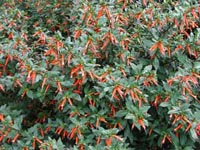Resource Library
Plant of the Week: Firecracker Plant (Cigar Plant)
The University of Arkansas System Division of Agriculture does not promote, support or recommend plants featured in "Plant of the Week." Please consult your local Extension office for plants suitable for your region.
Plant of the Week
Firecracker Plant, Cigar Plant
Latin: Cuphea ignea

The widespread availability of new plants from greenhouses and nurseries has made gardening a lot more fun, especially for us plantaholics.
With Independence Day upon us, I thought it would be fun to talk about the firecracker plant, Cuphea ignea.
This is a semi-woody shrub native to areas of southern Mexico and adjacent Caribbean islands. It grows about 2 feet tall and wide with a twiggy look. Cupheas are members of the loosestrife family, the same group to which crapemyrtle belongs.
Firecracker plants have deep green leaves with a shiny, blue-green cast. Leaves are about two inches long, oblong in outline and opposite one another up the stem. Flowers are borne singly at the nodes.
The plant gets its common names from the reddish-orange flowers which are cigar (cigarette) shaped and about and inch and a half long. At the tip of each bloom is a small band of violet and another of white, vaguely reminiscent of the ash at the end of a cigar - that is if you had a red cigar.
From the ends of the open flower protrudes the pistil that looks a bit like a fuse sticking out of the end of a ladyfinger. Another name applied to the plant - no doubt in a period of patriotic fervor - is red, white and blue flower.
Another connection to the fireworks theme is the way the seeds form, a characteristic you must be looking for to see. When the seeds mature, they are borne on a short peduncle that bursts open the round tube of the flower. The seeds are actually produced in a capsule which splits open when the flower tube is ruptured; the yellow seeds then appear individually on a short stem above the floral tube. A most unusual way of releasing seeds.
The species epitaph, "ignea" translates from Latin as "fire", and is common to lots of our words like ignite, ignition, and igneous (rock).
I first grew this charmer 25 years ago when I ordered seeds from the new and different section of the Parks Seed catalog. At the time it was the only Cuphea commonly available. Today, at least ten different species and hybrids are available from garden centers and nurseries. Almost all of these new ones are propagated by cuttings, which root easily from softwood, summertime cuttings.
Firecracker plant can be grown in the sunny flower border or in containers. It is free-branching and wants to spread, so use it with plants either having a cascading habit or a spikey growth form.
It does best in full sun, but will take light shade. Keep it watered and fed to keep it growing. New flowers follow growth, so if it stops growing, it will stop flowering. Being tropical, it doesn't blink at our summertime heat.
The tubular red flowers of this summertime bloomer make it an attractive plant for hummingbirds and butterflies.
The only down side I have found for cupheas in general is that Japanese beetles think they taste just fine. Otherwise, I have had no problems with my plants as long as they get reasonable care.
By: Gerald Klingaman, retired
Extension Horticulturist - Ornamentals
Extension News - July 1, 2005
The University of Arkansas System Division of Agriculture does not maintain lists of retail outlets where these plants can be purchased. Please check your local nursery or other retail outlets to ask about the availability of these plants for your growing area.